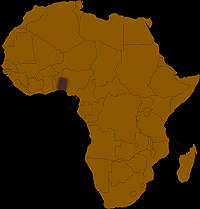
 |
The Yoruba are one of sub-Saharan Africa's best-known and most prolific art-producing peoples. They primarily live in southwestern Nigeria but are also located in the Republic of Benin, formerly called Dahomey. Traditionally, the Yoruba were politically centralized in numerous city-states led by paramount rulers. Each group developed distinctive yet related art traditions. Yoruba art is now designated by the name of the geographic locale a particular group inhabited. Some individual artists and workshops have also been identified.
The most famous Yoruba city-states were Ife (9th-18th century), Owo (11th-20th century), and Oyo (14th-19th century). Terra-cotta and cast-metal heads of exceptional quality have been found in Ife. Owo was a center for ivory and wood carving. Descriptions of old Oyo mention carved veranda posts, beaded silk hangings, and silver-covered palace doors. Other celebrated city-states such as Ijebu, Ketu, Ekiti, and Igbomina lend their names to distinctive carving traditions.
Various types of sculpture are used during rituals and ceremonies in which deities in the Yoruba pantheon are invoked. Other major art forms include textiles, beaded crowns for rulers, figurative implements used by herbalists, figures carved to honor deceased twins, cast copper-alloy ritual objects, and carved cups and boards used by diviners.
|


